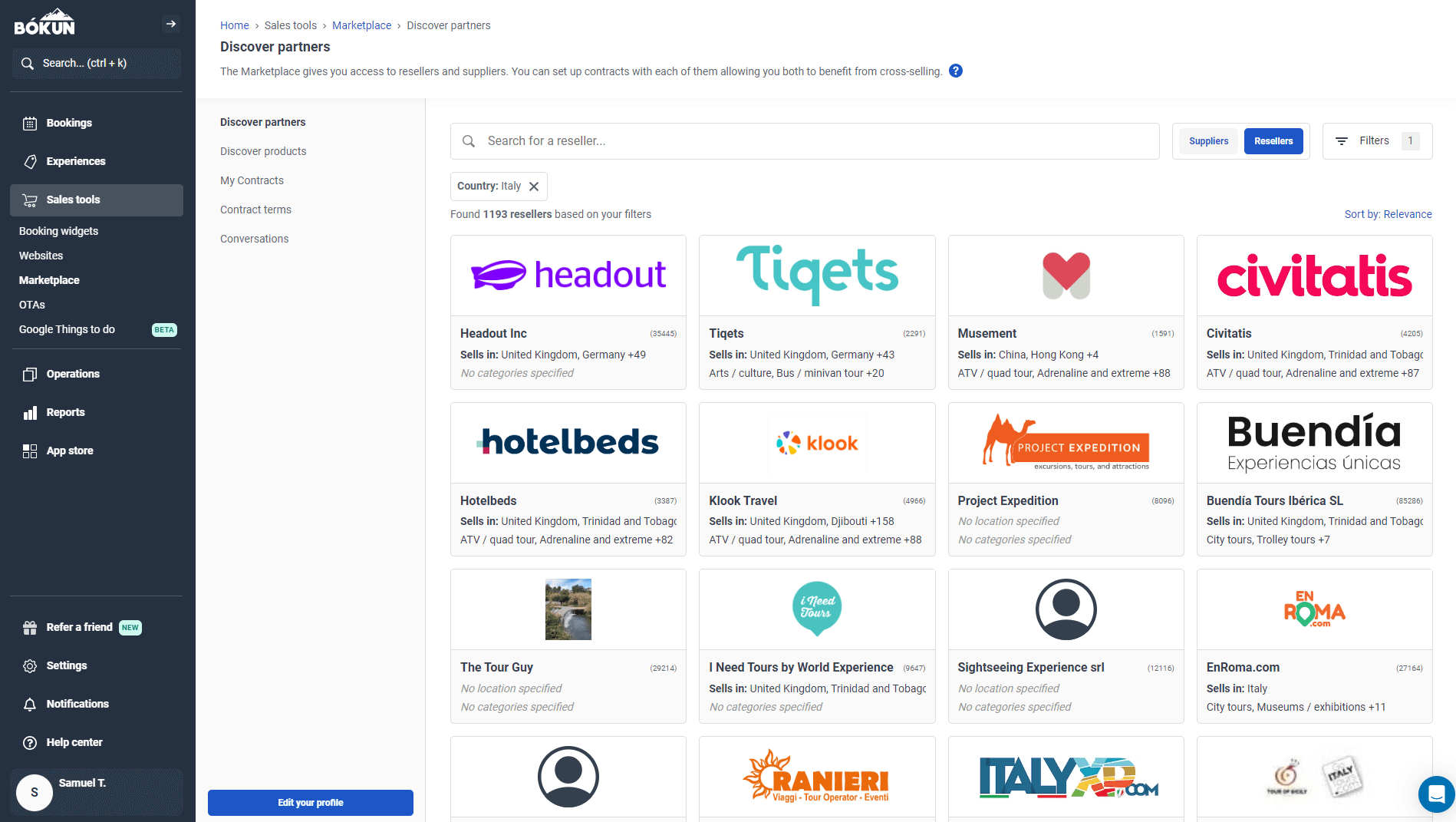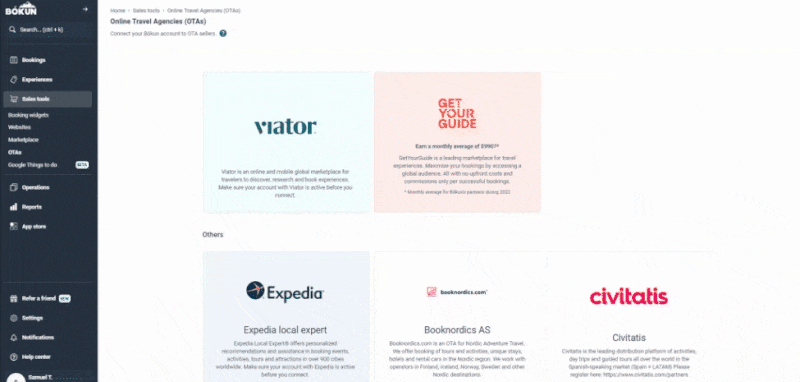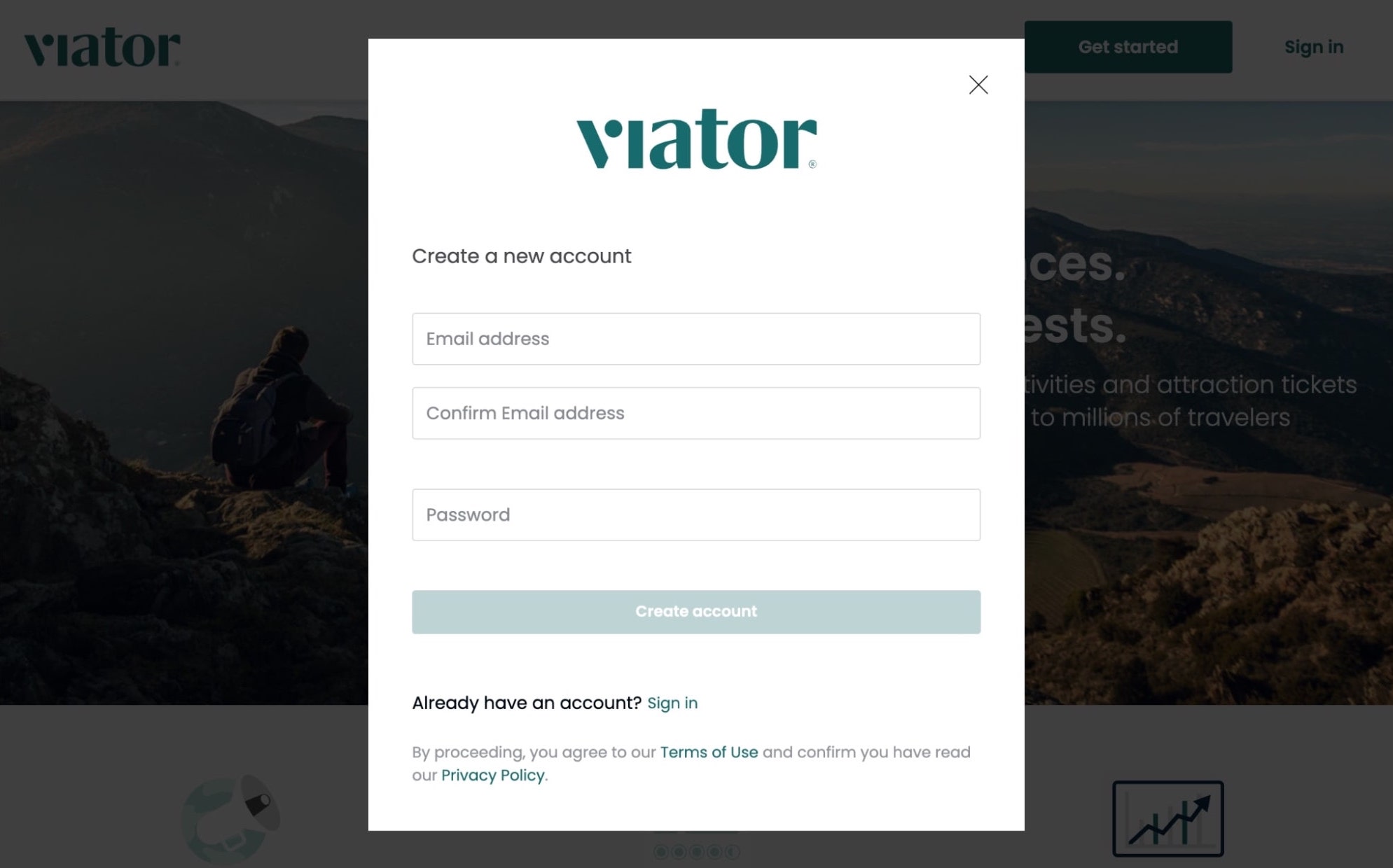There are two approaches for tour operators interested in partnering with travel agencies. You can:
- Connect and create contracts with reputable agents and agencies — not just in your area but worldwide. Then, they can promote your tours to their customers or include your experiences in travel packages.
- Join online travel agencies (OTAs) like Viator, GetYourGuide, Expedia, Trip.com, Klook, etc., to promote your tours in front of millions of travellers.
The first approach is arguably more challenging than listing tours on OTA websites, but both can be highly advantageous to growing your customer base and filling out your booking calendar. So, we’ll discuss how to leverage both avenues and use these resources to your benefit.
Our guide covers:
- The items to complete before reaching out to agents
- Strategies to source & connect with travel agents
- Ways to leverage partnerships & draw up contracts
- The best OTAs to join
- How to join OTAs & the associated costs
- Best practices for using OTAs
- Extra tips to grow your distribution network
Bókun tour operator software helps you manage bookings, availability, and customer experiences across all sales channels and partners. Our tool supports your operations as you grow so you can scale efficiently (while avoiding disorganisation and other blunders).
To explore our software and features, keep reading or start a free trial (no CC required).
How to establish partnerships with travel agents
Preliminary steps
Just as you want to partner with reputable agents, agents want to partner with reputable tour operators to be assured they’re suggesting high-quality experiences for their clients — and entering into mutually beneficial partnerships.
You want to show potential partners that you: 1) are well-organised, 2) have ideas for mutually beneficial partnerships, and 3) consistently provide five-star experiences for travellers.
So, we suggest that you:
- Create an online booking website or agent portal where agents can check availability and reserve bookings directly, eliminating the need for emails or back-and-forth communication. Once reservations are made, they’ll automatically appear on your calendar. It’s that simple.
- Have a strong understanding of your brand, experiences, niche, and position within the travel industry. Clear positioning of your tours and services helps travel agents promote you to the right audiences and incorporate your offerings into suitable itineraries.
- Setup business profiles on Google, Tripadvisor, and Yelp to collect customer reviews. This helps verify your brand and showcase your history of providing excellent customer service to potential partners and new customers.
Strategies to make connections
Only after completing these foundational items should you contact travel companies to discuss partnership opportunities.
When considering who to contact, think about your existing markets and markets you’d like to enter.
For example, if you run a wine tour company in Italy and find that most of your customers are from Europe but want to attract travellers from North America, you could reach out to US travel agencies to expand your customer base.
It can be helpful to:
- Attend travel expos, trade shows, and other local tourism events to network.
- Research highly-reviewed travel agents online. You may find people in your area, but you can also find agents in other regions or parts of the globe. You may use Google, LinkedIn, Travel Leaders, or Arival for this.
- On that same note — search for agencies or organisations that provide tourism experiences. For example, some agencies specialise in trips abroad for college students, so you could reach out to those organisations and suggest partnerships.
You can contact travel agents via email, phone, or social media. (More tips on how to craft these outreach messages below.)
In addition, many tour operator software systems provide B2B marketplaces for travel businesses to connect and create strategic partnerships. These systems often also have tools to create, store, and manage partner contracts.
Our solution, Bókun, includes a Marketplace with 27K+ partners in the travel and tourism industry. These include tour guides like yourself, travel agents, destination management officers (DMOs), hotel and resort chains, rental providers, attractions like museums and theme parks, and more.

The diversity of our network allows all tour companies to find complementary businesses for potential partnerships. Not only can you partner with travel agents, but you can also create packages or combo deals with hotels, car rentals, attractions, or other tour or activity providers. These partnerships can give you a leg up on competitors by allowing you to offer customers more convenient or unique experiences.
Bókun users who started selling through the Marketplace in 2023 saw an average GBV increase of 43% — see how one diving company increased bookings by 40% via Bókun Marketplace.
Leverage partnerships & establish contracts
When making the first contact with potential partners, you should clearly outline what you offer, what you’re requesting, and the mutual benefits of the partnership.
There are three common ways to leverage partnerships:
- Reselling your tours: You can ask partners to resell your tours and experiences. Travel agents can book your experiences for their clients, benefiting all parties — your bookings increase, they gain satisfied customers, and clients have a great experience.
- Combo experiences or travel packages: You can also suggest combo experiences or travel packages, which gives travel agents more opportunities to promote your experiences to relevant audiences. (You can even sell these packages on your site.)
- Reselling others’ experiences: While less relevant for travel agents, this approach can be beneficial when working with other tourism businesses or tour operators. By promoting others’ experiences to your customers, you earn commissions on bookings for your partners, allowing you to grow revenue without expanding your schedule or product line.
Read more: Three steps & best practices to create tour packages
After pitching high-level ideas and initiating partnership conversations, you must iron out the more nitty-gritty terms and conditions. Discuss commissions, promotional strategies, timelines, etc., and document these in a contract agreement. Then, both parties sign and agree on the terms.
Best practice: It’s a good idea to create a standardised contract you can amend quickly per partnership, as this speeds up the paperwork process when establishing bespoke agreements.
Don’t forget about online travel agencies (OTAs)
In addition to creating partnerships with travel agents, online travel agencies (OTAs) are invaluable for reaching new customers.
Instead of hiring and utilising travel agents, many travellers rely on OTAs to research destinations, plan vacations, and book travel with trusted providers because they’re free and convenient. (And in this digital age, their popularity only continues to grow.)
Some major OTAs include Viator, GetYourGuide, Expedia, Trip.com, Klook, Civitatis, Headout, Tiqets, and more.

Each of these sites sees millions of monthly visitors (so enrolling in just one or two of them can exponentially broaden your reach). Plus, everybody who visits these sites intends to research and book travel.
These are audiences in the market for what you offer and actively searching for travel experiences — so these are who you’re most likely to convert into customers.
In addition to these popular sites, there are also a variety of niche-specific OTAs for booking certain experience types. For example, there are OTAs for boat charters, food tours, bike tours, etc. You can research sites related to your specific offerings and list tours there.
Read more: 10+ best travel distribution channels for tour operators | Bókun
How to join OTAs & associated costs
Joining an OTA is easy and (usually) free — all you have to do is create a business account on each site, fill in some details and background about yourself, and submit your profile for review. Most OTAs have account-building tools that walk you through the steps to get started.

After creating an account, you can create listings for your tours and experiences. Again, most OTAs have product builders to walk you through this.
Here is where fees come into play. Most sites will charge for product or listing reviews (these may also be called subscription reviews, depending on the OTA).
If listings are approved, they’re added to the OTA site. If they’re denied, you’re back at the drawing board (and must edit, re-submit, and pay another fee).
Then, most OTAs charge a commission or booking fee on each reservation. Fees will vary from OTA to OTA, so we suggest reading the fine print to ensure you fully understand the pricing structure and what costs to expect (or contacting a customer service rep if you have more questions).
As a Viator preferred partner, we’ve written guides on using Viator and selling tours on their site. You can check out more details in our guides below:
- How does Viator work for tour operators, agents & travellers?
- How to sell tours on Viator & drive bookings | Bókun Partners
Best practices for using OTAs
Don’t overwhelm yourself by joining a dozen sites at once. Remember, each site sees millions of monthly visitors, and you only have so many bookings to fill.
Instead, select two to three major OTAs to test (check our list above for ideas) and a few niche-specific sites (you’ll want to research OTAs related to your industry).
Then, monitor the number of bookings you receive per channel to measure how these sites perform for you.
Perhaps you enrol in Viator, Tiqets, and a few niche-specific OTAs but receive 60% of business from Viator. This would tell you to list more experiences or open up more availability on that site. You could even take it a step further and run PPC campaigns on those sites to promote your experiences above or more frequently than competitors.
You can add more sales channels and gradually grow your distribution network. Test new channels and monitor performance, double down on channels that perform well for you, and experiment with adding new products or running PPC campaigns.
Then, as you broaden your distribution network, using a channel management system is essential. This way, you don’t have to manage bookings and availability on each site individually (and constantly jump between sites trying to keep everything updated in real-time).
A channel manager (like Bókun) allows all OTAs to work in sync. They feed bookings to a central calendar, and that calendar updates availability across all sites as you receive new reservations.
No matter where they find your tours, all travellers can see your current available time slots, so there’s no chance of double bookings.
We won’t discuss all of these systems in this post; we’ve written a complementary guide you can read here: Best OTA booking systems for tour operators.
Other tips to grow your distribution network & earn new customers
Here are a few extra tips to drive new bookings:
- Enable direct website bookings. The convenience of instantly booking online can help win new business.
- Utilise digital marketing strategies. Test paid advertising on OTAs or search engines like Google, run email marketing campaigns (more below), or even create blog content about travelling to your area, local tour options, and things to do in your local communities.
- Send periodic newsletters to update customers about your offerings or local events — share details on new tours or travel experiences, offer discounts or other incentives to return, or share other marketing materials. This helps customers remember your business so they can book again when they’re in town.
- Get active on social media. Create content based on experiences, encourage customers to follow and tag your page, and work with travel influencers.
- Encourage reviews and referrals on your business profile, website, and OTAs.
- SEO optimise your website, check usability, and ensure your site and booking engine are mobile-friendly.
Lastly, (as discussed above), you need to continually report on where bookings and revenue come from, then test new OTAs or renegotiate partnerships.
This isn’t a “set it and forget it” process. If you’re in the business of continually increasing bookings and revenue, then you need to track where you earn business and use that data to guide your growth strategies.
Check out more tips and details here: Ten ways to get more tour reservations
Getting started
We’re a Tripadvisor brand and Viator partner with over a decade of experience working with tour and activity providers to support and scale their operations. Our tour operator software, Bókun, includes an array of features to manage all areas of business. It includes:
- A centralised booking calendar
- Real-time availability management
- Product management & advanced tools like dynamic pricing to automatically adjust rates on tour listings
- Dozens of OTA connections & channel management
- A B2B reseller Marketplace to create partnerships with travel agencies and other tourism businesses
- Native CRM to store customer information & automate email communications (automatically send booking confirmations, tickets, retargeting emails, newsletters, referral requests, you name it)
- A reporting suite to measure sales channel and partner performance, pinpoint popular tours and experiences, and learn more about your customer base
We offer a free trial to explore our software and see how it works for your teams. After the trial, you can upgrade to a paid subscription to access our core features and join the B2B Marketplace. Then, we have extra perks for users selling on OTAs:
- We waive Bókun booking fees on Viator reservations so you can minimise costs from that channel.
- Our subscription includes a number of free Viator subscription checks each year (12, 24, or 48, depending on your plan).
- We offer the lowest booking fees among competitors — 1% to 1.5% — so you can keep costs low no matter which channel you sell on.
Related reads:

